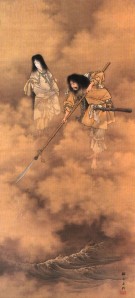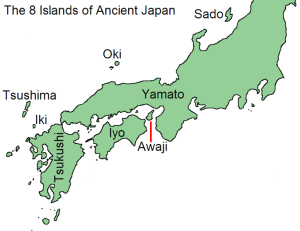 In Japanese mythology, the Japanese creation myth, Tenchikaibyaku ("Creation of Heaven and Earth"), is the story that describes the legendary birth of the celestial and earthly world, the birth of the first Gods and the birth of the Japanese archipelago.
In Japanese mythology, the Japanese creation myth, Tenchikaibyaku ("Creation of Heaven and Earth"), is the story that describes the legendary birth of the celestial and earthly world, the birth of the first Gods and the birth of the Japanese archipelago.Two books namely Kojiki, the first book written in Japan (712 AD), and the Nihon Shoki (720 AD) form the literary basis of Japanese mythology and Shinto.
According to the Kojiki, at the beginning the universe was immersed in a beaten and shapeless kind of matter (chaos), sunk in silence. Later there were sounds indicating the movement of particles. With this movement, the light and the lightest particles rose but the particles were not as fast as the light and could not go higher. Thus, the light was at the top of the Universe, and below it, the particles formed first the clouds and then Heaven, which was to be called Takamagahara (“High Plain of Heaven"). The rest of the particles that had not risen formed a huge mass, dense and dark, to be called Earth.
When Takamagahara was formed, five deities known as Kotoamatsukami appeared spontaneously.
Subsequently two other gods arose after which five pairs of gods were born (total of ten deities), each pair consisting of a male deity and a female deity.
All these 12 deities are collectively called as Kamiyonanayo ( "Seven Divine Generations").
Following the creation of Heaven and Earth and the appearance of these primordial gods, the last pair of the Kamiyonanayo - Izanagi and Izanami went on to create the Japanese archipelago (Kuniumi) and gave birth to a large number of gods (Kamiumi).
[caption id="attachment_644" align="aligncenter" width="135"]
 Izanami and Izanagi churning the sea[/caption]
Izanami and Izanagi churning the sea[/caption]To help them to achieve this, Izanagi and Izanami were given a Naginata decorated with jewels, named Ame-no-nuboko ("Heavenly Jeweled Spear"). The two deities then went to the bridge between heaven and earth, Amenoukihashi ("Floating Bridge of Heaven") and churned the sea below with the halberd ( two-handed pole weapon).
Drops of salty water formed the island, Onogoro ("self-forming"). The deities descended from the bridge of heaven and made their home on the island. Eventually, they fell in love and wished to procreate.
From their union were born the Oyashima, or the eight great islands of Japan:
[caption id="attachment_645" align="aligncenter" width="300"]
 8 Islands of Ancient Japan[/caption]
8 Islands of Ancient Japan[/caption]1. Awaji
2. Iyo
3. Oki
4. Tsukushi
5. Iki
6. Tsushima
7. Sado
8. Yamato
Thus we see that the concept of “churning a water body” is also present in mythologies other than that of the Hindus.
Nice read...:) thnx for something new
ReplyDelete